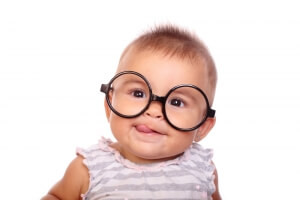 It is difficult to test your baby’s vision before about age 3, when she can describe what she’s seeing. But even before your baby can speak, there are ways to identify vision problems.
It is difficult to test your baby’s vision before about age 3, when she can describe what she’s seeing. But even before your baby can speak, there are ways to identify vision problems.
Parents spend a lot more time with their baby than the pediatricians does, and they spend a lot of that time gazing into their baby’s eyes. So even though they may not have medical degrees, parents are often the first ones to spot problems in a baby’s developing vision.
The baby’s ability to track movement with her eyes is the first thing parents should watch for. As early as 2 or 3 months, a baby developing normally will begin to fix her eyes on an object and follow the object as it moves.
Parents can also check that a baby’s two eyes are aligned with each other. In early infancy, drifting of the eyes is normal. But if drifting or crossing of the eyes persists, you should alert your doctor.
Finally, parents should report any whiteness in the pupil of the eye. That can be a sign of eye disease.
Pediatric ophthalmologists have specialized instruments to diagnose possible vision problems in babies before they can speak, but these tests can be considered elective and can be expensive, so parents may want to discuss the options with their pediatrician before requesting them.
Source: http://www.everydayhealth.com January 17, 2013






